Investigation of Microstructures and Mechanical Properties of SiC/AA2024 Nanocomposites Processed by Powder Metallurgy and T6 Heat Treatment
Abstract
:1. Introduction
2. Materials and Methods
3. Results
3.1. Morphology of 1 and 5 vol.% SiC/AA2024 Nanocomposites
3.2. Tensile Properties
4. Discussion
4.1. Microstructures
4.2. Mechanical Properties
5. Conclusions
- (1)
- A bimodal microstructure formed in the as-extruded samples and still remained after T6 heat treatment, which is likely owing to the pinning effect of the dispersed SiC nanoparticles on grain boundaries.
- (2)
- With increasing SiC nanoparticle content from 1 to 5 vol.%, the yield strength and ultimate tensile strength increased from 413 and 501 MPa to 461 and 565 MPa, respectively, and the elongation to fracture decreased from 5.4% to 4.1%.
- (3)
- After T6 heat treatment, the 1 vol.% SiC/AA2024 nanocomposite sample revealed an improvement in both strength and ductility, where the YS, UTS, and El increased from 413 MPa, 501 MPa, and 5.4% to 496 MPa, 572 MPa, and 6.7%, respectively.
- (4)
- The simultaneous increase in strength and ductility in the T6 heat-treated 1 vol.% SiC/AA2024 nanocomposite sample may be attributed to the bimodal microstructure, which could generate back stress strengthening during tensile deformation, as well as the dispersed intragranular Sʹ precipitates which could accumulate dislocations by blocking dislocation movement.
Author Contributions
Funding
Institutional Review Board Statement
Informed Consent Statement
Data Availability Statement
Acknowledgments
Conflicts of Interest
References
- Mohammed, A.S.; Aljebreen, O.S.; Hakeem, A.S.; Laoui, T.; Patel, F.; Baig, M.M.A. Tribological Behavior of Aluminum Hybrid Nanocomposites Reinforced with Alumina and Graphene Oxide. Materials 2022, 15, 865. [Google Scholar] [CrossRef]
- Wang, Z.; Li, C.; Wang, H.; Zhu, X.; Wu, M.; Li, J.; Jiang, Q. Aging Behavior of Nano-SiC/2014Al Composite Fabricated by Powder Metallurgy and Hot Extrusion Techniques. J. Mater. Sci. Technol. 2016, 32, 1008–1012. [Google Scholar] [CrossRef]
- Wang, W.-J.; Yung, K.-C.; Tang, A.-D.; Choy, H.-S.; Lv, Z. Evolution of Microstructure, Texture and Mechanical Properties for Multilayered Al Matrix Composites by Accumulative Roll Bonding. Materials 2021, 14, 5576. [Google Scholar] [CrossRef]
- Yao, X.; Zhang, Z.; Zheng, Y.; Kong, C.; Quadir, Z.; Liang, J.; Chen, Y.; Munroe, P.; Zhang, D. Effects of SiC Nanoparticle Content on the Microstructure and Tensile Mechanical Properties of Ultrafine Grained AA6063-SiCnp Nanocomposites Fabricated by Powder Metallurgy. J. Mater. Sci. Technol. 2017, 33, 1023–1030. [Google Scholar] [CrossRef]
- Park, J.G.; Keum, D.H.; Lee, Y.H. Strengthening mechanisms in carbon nanotube-reinforced aluminum composites. Carbon 2015, 95, 690–698. [Google Scholar] [CrossRef]
- Canakci, A.; Varol, T. Microstructure and properties of AA7075/Al–SiC composites fabricated using powder metallurgy and hot pressing. Powder Technol. 2014, 268, 72–79. [Google Scholar] [CrossRef]
- Sabbar, H.M.; Leman, Z.; Shamsudin, S.; Tahir, S.M.; Jaafar, C.N.A.; Ariff, A.H.M.; Zahari, N.I.; Rady, M.H. The Effect of Solid-State Processes and Heat Treatment on the Properties of AA7075 Aluminum Waste Recycling Nanocomposite. Materials 2021, 14, 6667. [Google Scholar] [CrossRef] [PubMed]
- Samal, S.; Molnárová, O.; Průša, F.; Kopeček, J.; Heller, L.; Šittner, P.; Škodová, M.; Abate, L.; Blanco, I. Net-Shape NiTi Shape Memory Alloy by Spark Plasma Sintering Method. Appl. Sci. 2021, 11, 1802. [Google Scholar] [CrossRef]
- Samal, S.; Tyc, O.; Cizek, J.; Klecka, J.; Lukáč, F.; Molnárová, O.; de Prado, E.; Weiss, Z.; Kopeček, J.; Heller, L.; et al. Fabrication of Thermal Plasma Sprayed NiTi Coatings Possessing Functional Properties. Coatings 2021, 11, 610. [Google Scholar] [CrossRef]
- Fan, G.; Jiang, Y.; Tan, Z.; Guo, Q.; Xiong, D.-B.; Su, Y.; Lin, R.; Hu, L.; Li, Z.; Zhang, D. Enhanced interfacial bonding and mechanical properties in CNT/Al composites fabricated by flake powder metallurgy. Carbon 2018, 130, 333–339. [Google Scholar] [CrossRef]
- Roshan, M.R.; Mirzaei, M.; Jahromi, S.A.J. Microstructural characteristics and tensile properties of nano-composite Al 2014/4wt.% Al2O3 produced from machining chips. J. Alloys Compd. 2013, 569, 111–117. [Google Scholar] [CrossRef]
- Mo, Z.; Liu, Y.; Geng, J.; Wang, T. The effects of temperatures on microstructure evolution and mechanical properties of B4C–AA2024 composite strips prepared by semi-solid powder rolling. Mater. Sci. Eng. A 2015, 652, 305–314. [Google Scholar] [CrossRef]
- Canakci, A.; Varol, T.; Erdemir, F. The Effect of Flake Powder Metallurgy on the Microstructure and Densification Behavior of B4C Nanoparticle-Reinforced Al–Cu–Mg Alloy Matrix Nanocomposites. Arab. J. Sci. Eng. 2015, 41, 1781–1796. [Google Scholar] [CrossRef]
- Verma, V.; Sayyed, A.H.M.; Sharma, C.; Shukla, D.K. Tensile and fracture properties of epoxy alumina composite: Role of particle size and morphology. J. Polym. Res. 2020, 27, 388. [Google Scholar] [CrossRef]
- Shaeri, M.; Salehi, M.; Seyyedein, S.; Abutalebi, M. Effect of equal channel angular pressing on aging treatment of Al-7075 alloy. Prog. Nat. Sci. 2015, 25, 159–168. [Google Scholar] [CrossRef] [Green Version]
- Zhu, Y.; Wu, X. Perspective on hetero-deformation induced (HDI) hardening and back stress. Mater. Res. Lett. 2019, 7, 393–398. [Google Scholar] [CrossRef] [Green Version]
- Luo, Y.; Zhang, Z.; Xie, Y.; Liang, J.; Zhang, D. The role of nanoscale heterogeneous structure in simultaneously enhancing strength and ductility of high-oxygen Ti–6Al–4V alloy. Powder Met. 2020, 64, 142–148. [Google Scholar] [CrossRef]
- Ma, X.; Huang, C.; Moering, J.; Ruppert, M.; Höppel, H.W.; Göken, M.; Narayan, J.; Zhu, Y. Mechanical properties of copper/bronze laminates: Role of interfaces. Acta Mater. 2016, 116, 43–52. [Google Scholar] [CrossRef] [Green Version]
- Yang, M.; Pan, Y.; Yuan, F.; Zhu, Y.; Wu, X. Back stress strengthening and strain hardening in gradient structure. Mater. Res. Lett. 2016, 4, 145–151. [Google Scholar] [CrossRef]
- Mu, D.K.Q.; Zhang, Z.; Xie, Y.H.; Liang, J.M.; Wang, J.; Zhang, D.L. The microstructures and mechanical properties of a 5vol%SiC/AA2024 nanocomposite fabricated by powder metallurgy. Mater. Charact. 2021, 175, 111090. [Google Scholar] [CrossRef]
- Samal, S.; Cho, S.; Kim, H. Bimodal distribution of filler on viscosity and thermal expansion of glass composites. Ceram. Int. 2013, 39, 1659–1666. [Google Scholar] [CrossRef]
- Wu, X.; Zhu, Y. Heterogeneous materials: A new class of materials with unprecedented mechanical properties. Mater. Res. Lett. 2017, 5, 527–532. [Google Scholar] [CrossRef]
- Lin, Y.; Xia, Y.-C.; Jiang, Y.-Q.; Zhou, H.-M.; Li, L.-T. Precipitation hardening of 2024-T3 aluminum alloy during creep aging. Mater. Sci. Eng. A 2012, 565, 420–429. [Google Scholar] [CrossRef]
- Abarghouie, S.M.R.M.; Reihani, S.M.S. Aging behavior of a 2024 Al alloy-SiCp composite. Mater. Des. (1980–2015) 2010, 31, 2368–2374. [Google Scholar] [CrossRef]
- Wang, S.C.; Starink, M.J. Two types of S phase precipitates in Al–Cu–Mg alloys. Acta Mater. 2007, 55, 933–941. [Google Scholar] [CrossRef] [Green Version]
- Pandey, C.; Saini, N.; Mahapatra, M.M.; Kumar, P. Study of the fracture surface morphology of impact and tensile tested cast and forged (C&F) Grade 91 steel at room temperature for different heat treatment regimes. Eng. Fail. Anal. 2017, 71, 131–147. [Google Scholar]
- Saini, N.; Pandey, C.; Mahapatra, M.M.; Narang, H.; Mulik, R.; Kumar, P. A comparative study of ductile-brittle transition behavior and fractography of P91 and P92 steel. Eng. Fail. Anal. 2017, 81, 245–253. [Google Scholar] [CrossRef]
- Samala, S.; Mohapatrab, B.K.; Mukherjeeb, P.S. The Effect of Heat Treatment on Titania Slag. J. Miner. Mater. Charact. Eng. 2010, 9, 795–809. [Google Scholar] [CrossRef]
- Shanmugasundaram, T.; Heilmaier, M.; Murty, B.S.; Sarma, V.S. On the Hall–Petch relationship in a nanostructured Al–Cu alloy. Mater. Sci. Eng. A 2010, 527, 7821–7825. [Google Scholar] [CrossRef]
- Parel, T.S.; Wang, S.C.; Starink, M.J. Hardening of an Al–Cu–Mg alloy containing Types I and II S phase precipitates. Mater. Des. 2010, 31, S2–S5. [Google Scholar] [CrossRef]
- Liu, Z.; Wang, Q.; Xiao, B.; Ma, Z.; Liu, Y. Experimental and modeling investigation on SiCp distribution in powder metallurgy processed SiCp/2024 Al composites. Mater. Sci. Eng. A 2010, 527, 5582–5591. [Google Scholar] [CrossRef]
- Sathiyamoorthi, P.; Kim, H.S. High-entropy alloys with heterogeneous microstructure: Processing and mechanical properties. Prog. Mater. Sci. 2020, 123, 100709. [Google Scholar] [CrossRef]
- Ovid’Ko, I.; Valiev, R.; Zhu, Y. Review on superior strength and enhanced ductility of metallic nanomaterials. Prog. Mater. Sci. 2018, 94, 462–540. [Google Scholar] [CrossRef]
- Yang, C.; Muránsky, O.; Zhu, H.; Thorogood, G.J.; Huang, H.; Zhou, X. On the origin of strengthening mechanisms in Ni-Mo alloys prepared via powder metallurgy. Mater. Des. 2017, 113, 223–231. [Google Scholar] [CrossRef]
- Zhang, Z.; Xie, Y.; Huo, X.; Chan, S.; Liang, J.; Luo, Y.; Mu, D.; Ju, J.; Sun, J.; Wang, J. Microstructure and mechanical properties of ultrafine grained CoCrFeNi and CoCrFeNiAl0.3 high entropy alloys reinforced with Cr2O3/Al2O3 nanoparticles. Mater. Sci. Eng. A 2021, 816, 141313. [Google Scholar] [CrossRef]
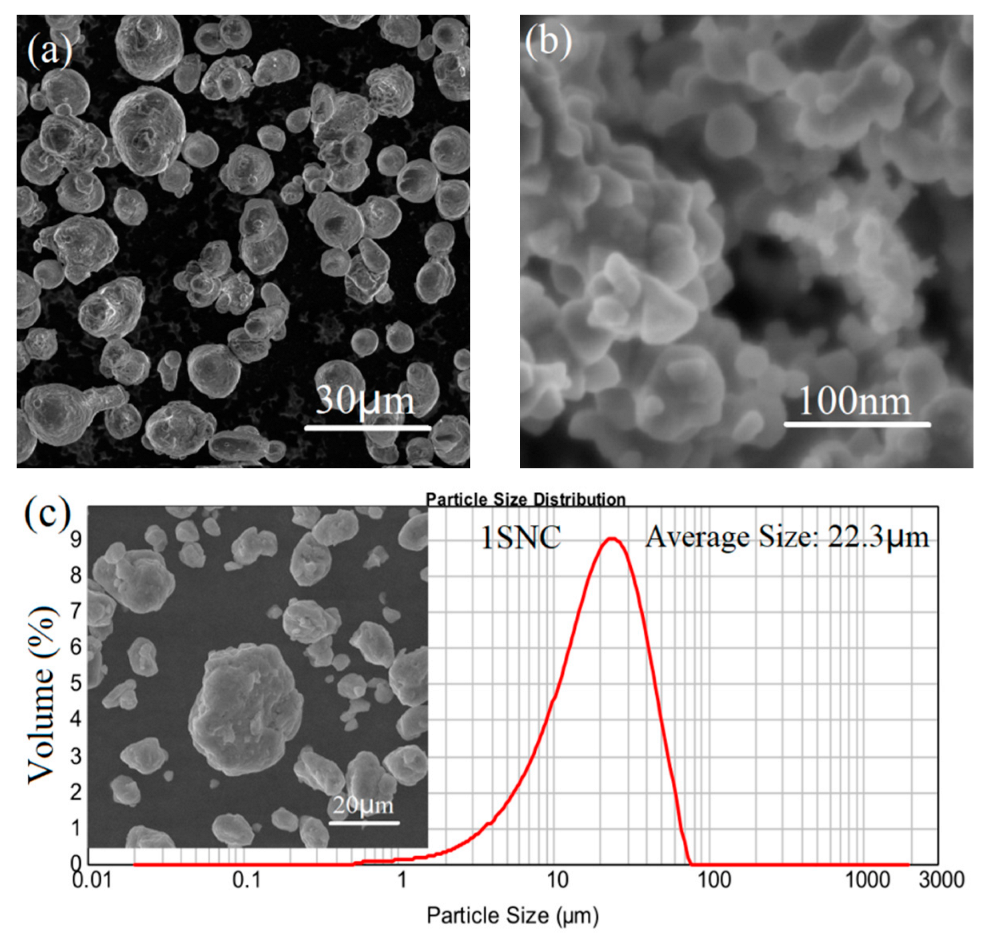
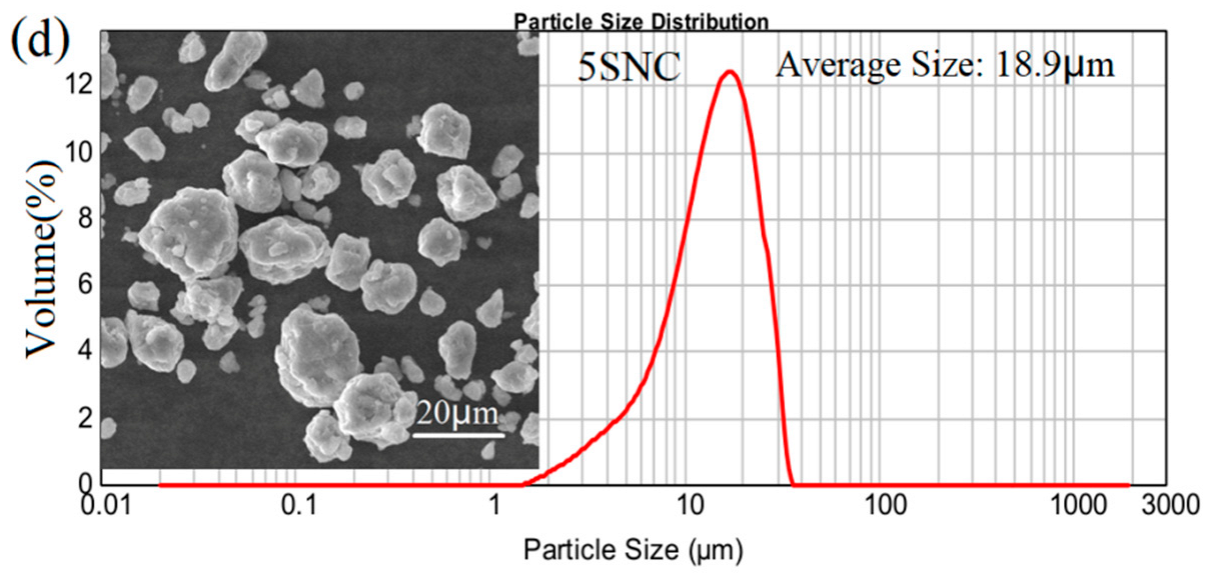
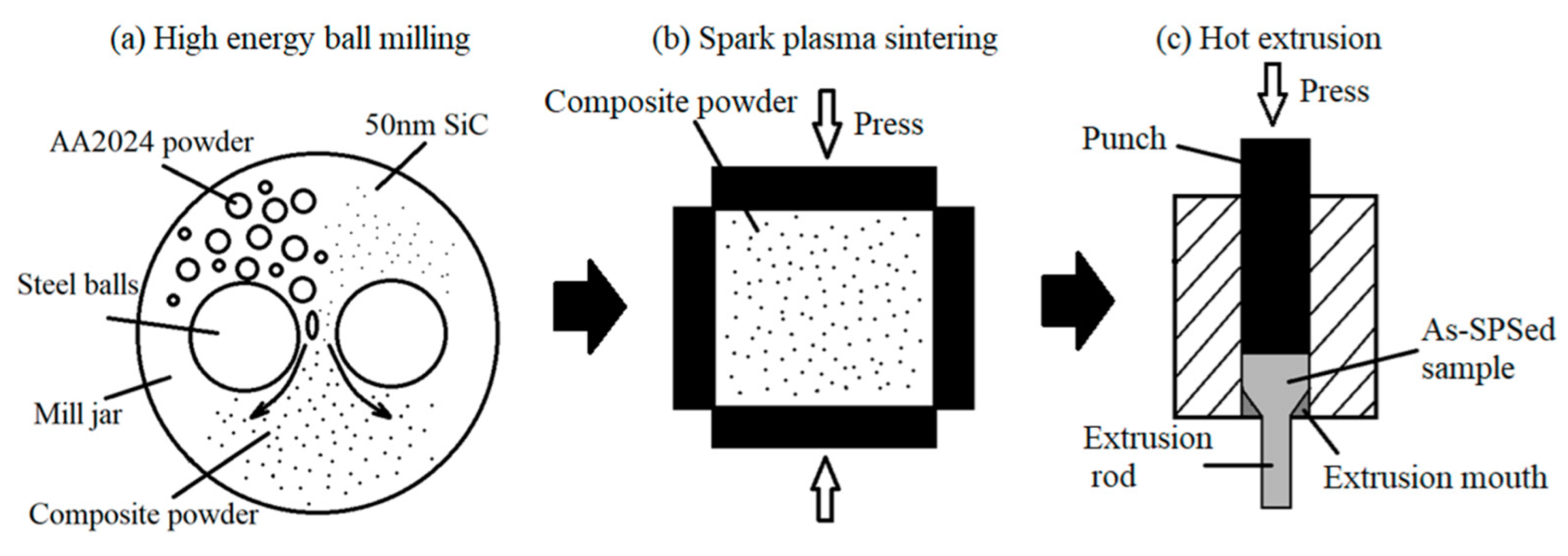
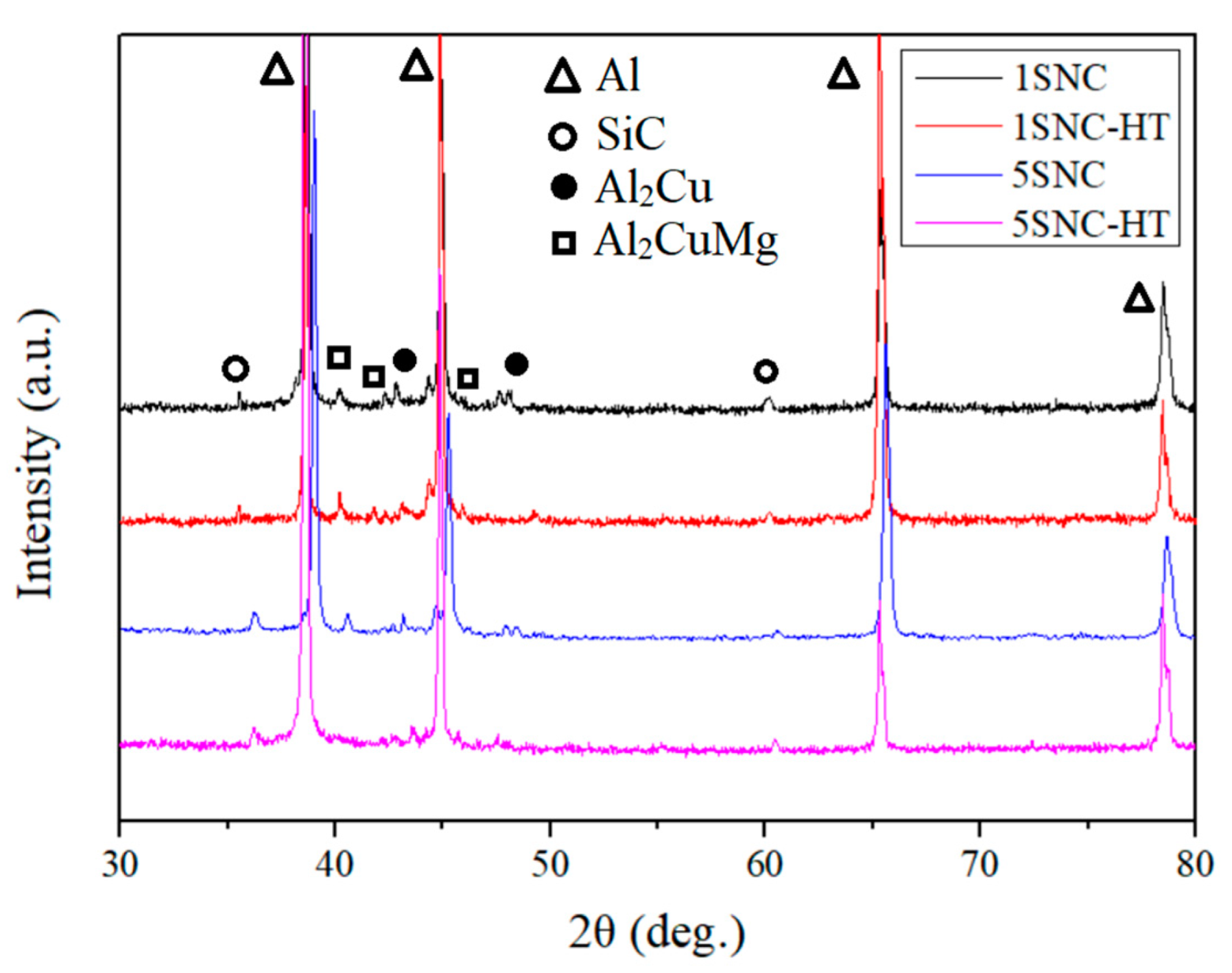
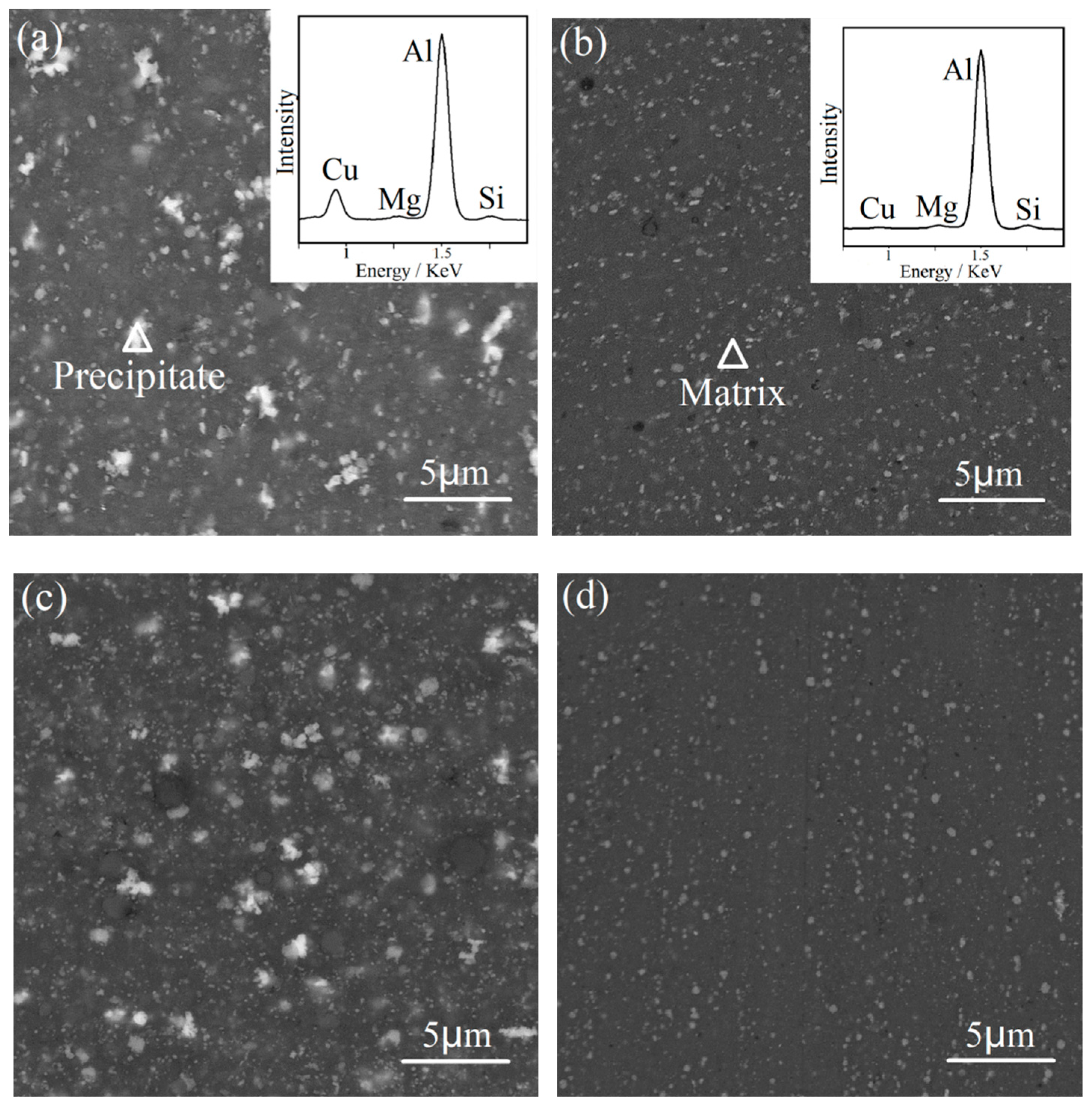
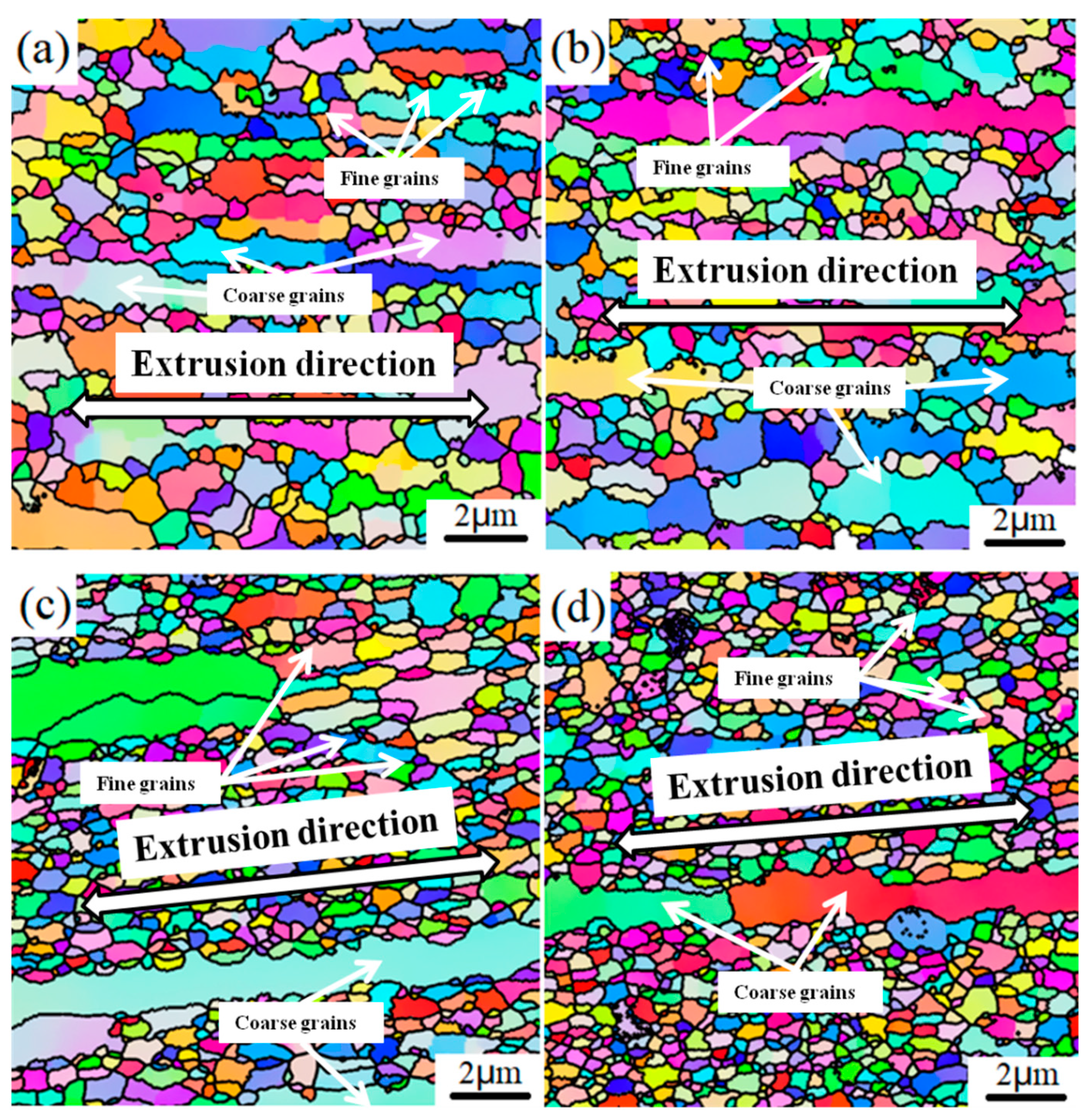
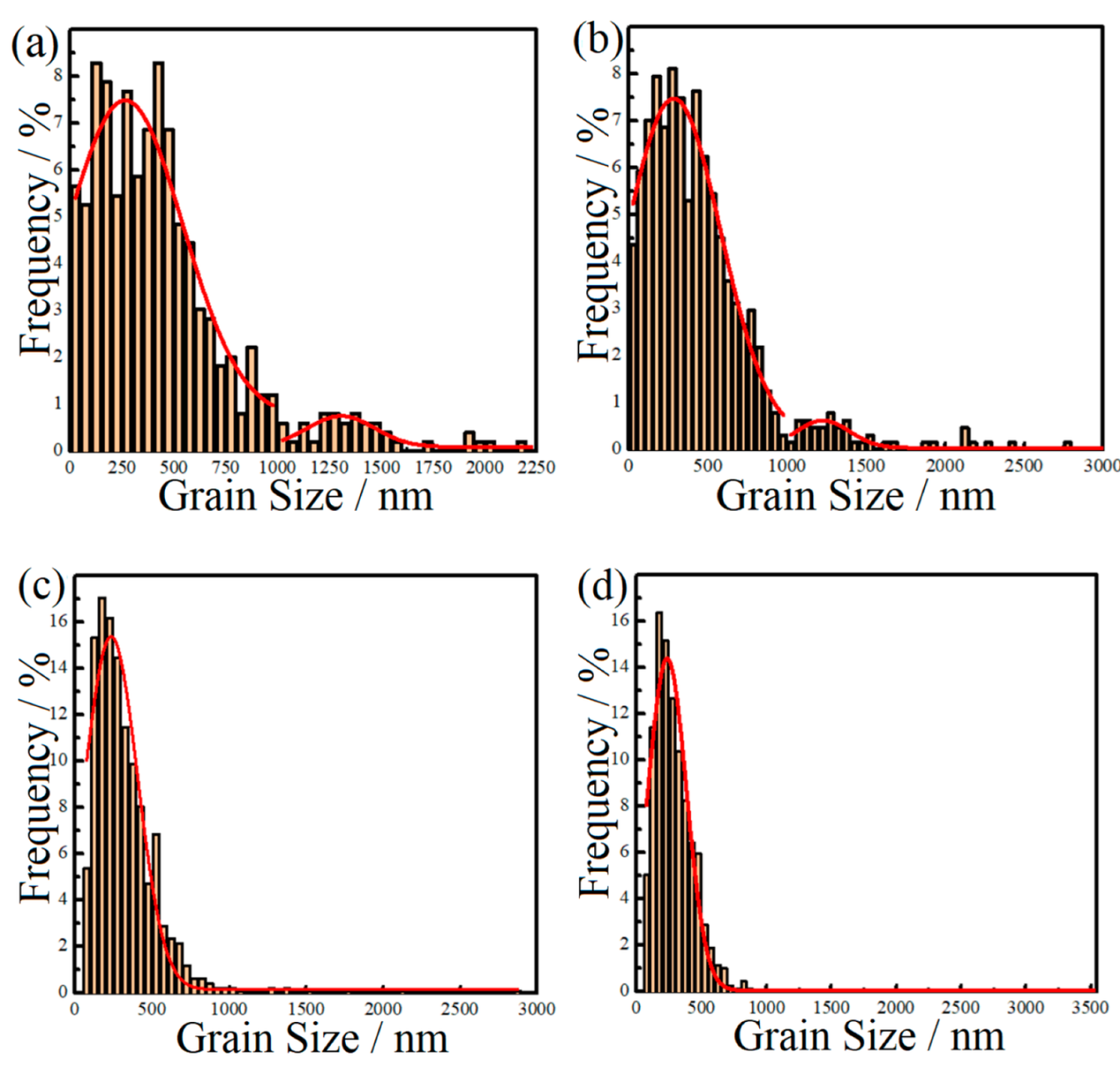
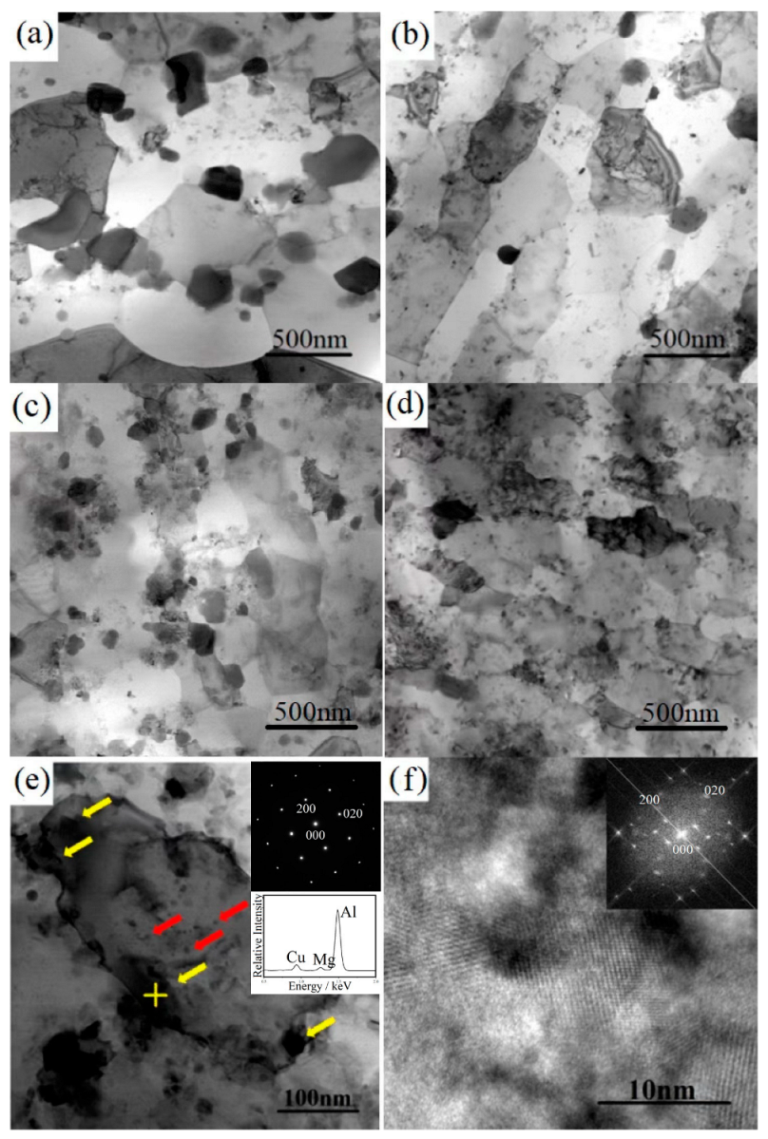
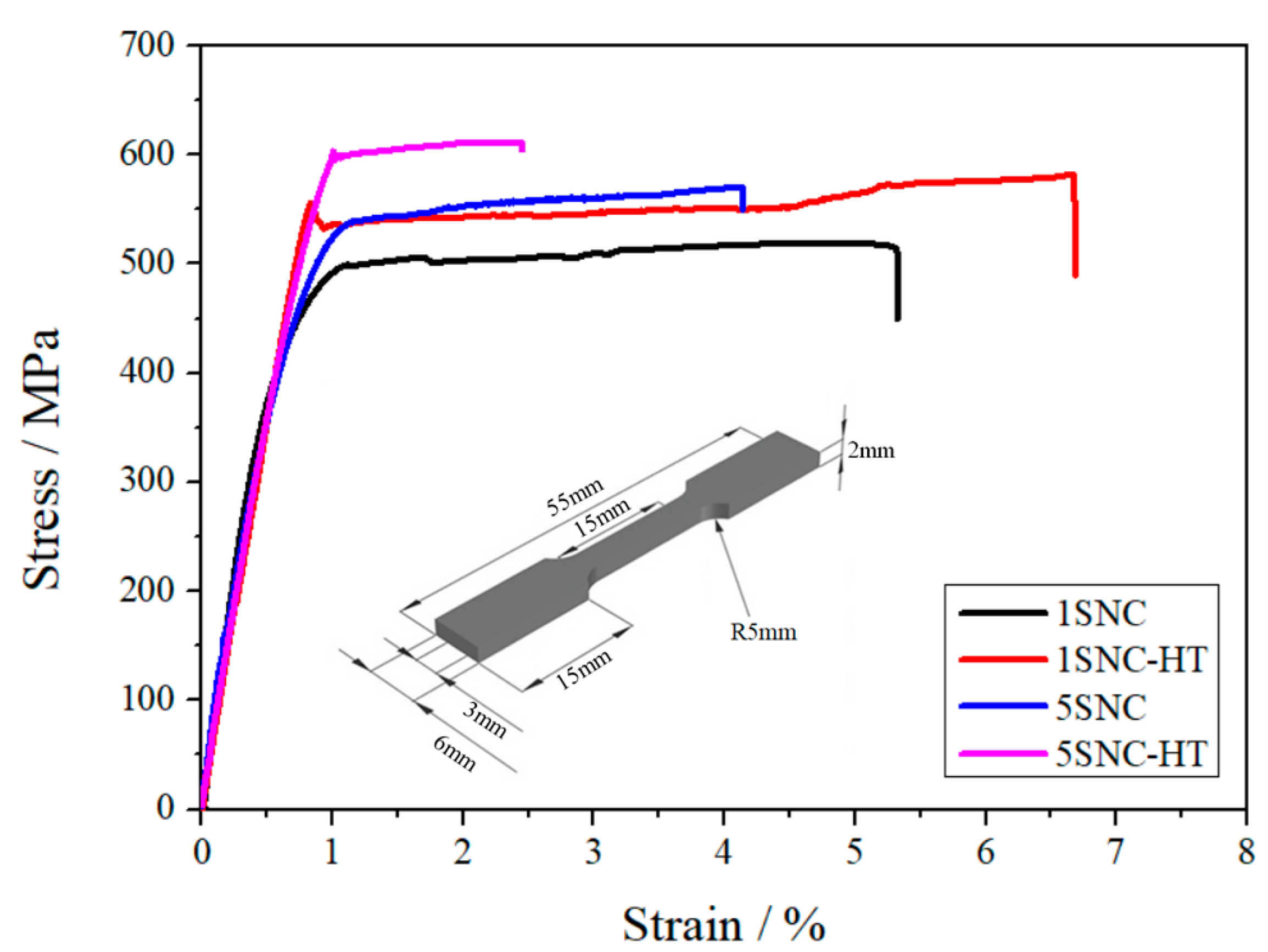

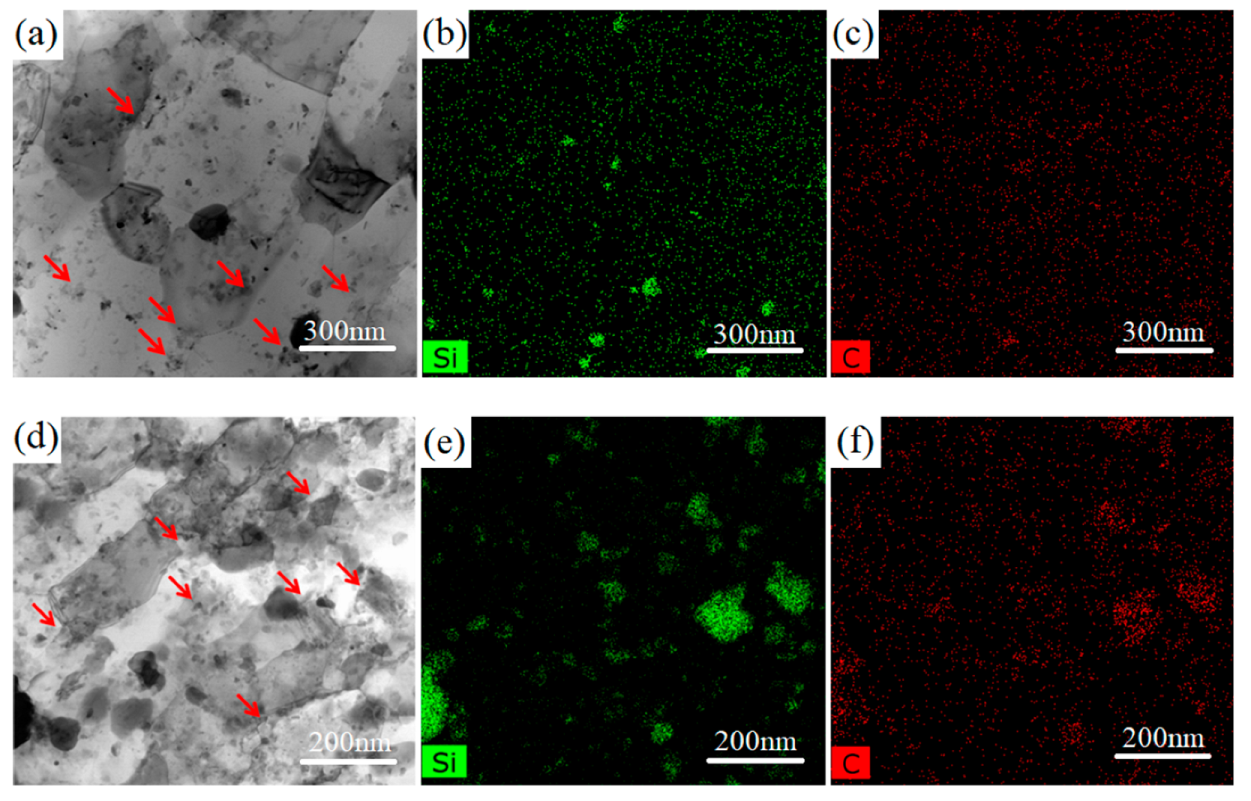


| Element | Cu | Mg | Fe | Mn | Si | Zn | Al |
|---|---|---|---|---|---|---|---|
| Composition | 4.15 | 1.56 | 0.22 | 0.75 | 0.16 | 0.16 | Bal. |
| Samples | Yield Strength/MPa | Ultimate Tensile Strength/MPa | Elongation to Fracture/% |
|---|---|---|---|
| 1SNC | 413 ± 5 | 501 ± 8 | 5.4 ± 0.4 |
| 1SNC-HT | 496 ± 9 | 572 ± 12 | 6.7 ± 0.6 |
| 5SNC | 461 ± 7 | 565 ± 9 | 4.1 ± 0.3 |
| 5SNC-HT | 594 ± 10 | 613 ± 17 | 2.4 ± 0.8 |
Publisher’s Note: MDPI stays neutral with regard to jurisdictional claims in published maps and institutional affiliations. |
© 2022 by the authors. Licensee MDPI, Basel, Switzerland. This article is an open access article distributed under the terms and conditions of the Creative Commons Attribution (CC BY) license (https://creativecommons.org/licenses/by/4.0/).
Share and Cite
Mu, D.; Zhang, Z.; Liang, J.; Wang, J.; Zhang, D. Investigation of Microstructures and Mechanical Properties of SiC/AA2024 Nanocomposites Processed by Powder Metallurgy and T6 Heat Treatment. Materials 2022, 15, 3547. https://doi.org/10.3390/ma15103547
Mu D, Zhang Z, Liang J, Wang J, Zhang D. Investigation of Microstructures and Mechanical Properties of SiC/AA2024 Nanocomposites Processed by Powder Metallurgy and T6 Heat Treatment. Materials. 2022; 15(10):3547. https://doi.org/10.3390/ma15103547
Chicago/Turabian StyleMu, Dikunqi, Zhen Zhang, Jiamiao Liang, Jun Wang, and Deliang Zhang. 2022. "Investigation of Microstructures and Mechanical Properties of SiC/AA2024 Nanocomposites Processed by Powder Metallurgy and T6 Heat Treatment" Materials 15, no. 10: 3547. https://doi.org/10.3390/ma15103547





